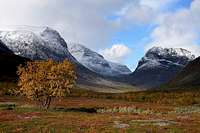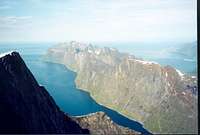|
|
Area/Range |
|---|---|
|
|
68.31820°N / 18.76470°E |
|
|
Hiking, Mountaineering, Trad Climbing, Toprope, Ice Climbing, Mixed, Scrambling, Skiing |
|
|
Spring, Summer, Fall, Winter |
|
|
6946 ft / 2117 m |
|
|
Overview
 Vistasvagge, Sweden. Photo by mcbain.
Vistasvagge, Sweden. Photo by mcbain.The Arctic circle is an imaginary line, about approximately 2600 km south of the North Pole. In reality, the Arctic Circle is perpetually moving, its geographical position is not static. It can move more than 100 metres per year. It's not always found where it was yesterday... With modern technology the location of the Arctic Circle can be exactly pinpointed in real-time. (For tourist reasons there exists a fixed line.)
So what defines "arctic"? Arctic Scandinavia is defined by nature and the sun. It goes all the way up north, to Barents Sea in the Arctic Ocean, Svalbard belongs (part of Norway), but how far south? I'd say everything above 65 degrees north is arctic, below sub-arctic. The nature is mainly tundra. Frozen ground is above the tree line and is covered with plants like moss and lichen. Trees that are usually small. Low temperatures and precipitation with strong winds are not uncommon in the Arctic.
 Sarek, Sweden. Photo by Mr White.
Sarek, Sweden. Photo by Mr White.The sun plays a very important role up here. The extremes of daylight makes a very special environment to live in. No sun at all or sun all the time. During a few months in spring and autumn there is both day and night.
There is one equivalent the same distance from the South Pole. Above this line the sun never sets during the summer solstice, and during winter solstice it will never rise. These phenomen has many popular names as the Midnight sun or the Eternal night, the Polar night. Up here the long day last from approx. 25 of May to 18 of July. The Arctic circles change their positions due to the relationship between earth's axis and the sun. At the moment it moves 14,4 meters/year. It affects the weather patterns in the northern hemisphere.
This page is only concerned with Norway, Sweden and Finland, but Canada, Greenland, Iceland, Russia and the United States are also part of the Arctic. It is an area with 2 million people in it and over 50 languages.
In the menu to the left, right under "Children", there is a link to the map of the mountains in the area.
Getting There
Sweden:
Take the train or airplane to Kiruna, the most northern town in Sweden.
The trains takes 26 hours from Malmö in southern Sweden, if you want to continue by train from Europe. From Stockholm it takes 20 hours. There are sleeping wagons with different standards on beds. Nowadays it's not one company all the way, but on the site you get the entire trip planned.
The flight (SAS) takes between 1,5 or 2,25 hours från Stockholm, depending on chosen flight.
Nordic Airlink (link to English on page) flies to Kiruna as well, departing from Arlanda. Fares are SEK 349-899 one way, depending on seat availability, flights are in the early evening. It's also possible to fly on standby to Kiruna, and pay 400 SEK from Arlanda and 700 SEK from Malmo with SAS, when you're under 26.
Norway:
One can take the train from Oslo. Scanrail is a pass which allows you to travel in all Scandinavia, for 21 days. There's also Scanrail Flexi, which gives you 5 travelling days during a 15-day period. Euro Domino is another kind of pass, allows you to travel in one or several countries during a month. One chooses 1-8 travel days during that period. NSB, the Norwegian train company
There are also buses from Oslo.
To get out to Lofoten, take the ferry from Bodö to Röst or go by Hurtigrutten You can bring your car on some of the Hurtigruttenboats. The ferry company, OVDS has car ferries, fast ferries and the Hurtigruten. One can only book for the car during summermonths (June-Aug). It costs 132 NOK for a grown up during winter and the winter timetable says one boat a day.
One can also fly from Oslo Braathens or Wideroe. One can also drive all the way through Norway, but it's a very long trip.
One can easily move between Norway and Sweden by train. There's a railway between Kiruna and Narvik. From Narvik take the boat.
Finland:
This I have COPIED from the Halti page, instead of rewriting the same information:
"Finland has a surprisingly dense air transportion network with hourly flights between Helsinki and Lapland. Best served from Helsinki is the City of Rovaniemi (capital of the Lapland Provice), as well as the ski-resort town of Kittilä. The closest airport to Halti is at Enontekiö, but there are only two flights per week from Helsinki. The two airlines with regular service to Rovaniemi and Kittilä are Finnair, the national airline of Finland, and it's competitor, Blue1, a member of the SAS Group.
Finnair (One World Alliance)
Blue1 (Star Alliance)
So, I would suggest flying either to Rovaniemi or Kittilä (about 1h 20min. flight from Helsinki) and renting a car from either airport. Most well-known international car rental companies (Hertz, Avies, Budget, etc.) serve these airports. Distance from Rovaniemi to Kilpisjärvi: 427km (driving time 5h30min.) and from Kittilä 276km (3h30min.)
If you want to get from Kilpisjärvi to Halti fast, and money is not an issue, there is a sea plane operator at Kilpisjärvi. From there you can hire a plane to take you to one of the many lakes in the area, from where it only takes you a few hours to trek to the top of Halti."
The Mountains
 Nordkapp, Norway. Photo by foweyman
Nordkapp, Norway. Photo by foweymanThe mountains of Nordland, Norway and the Swedish mountains lies fairly close to each other. It is possible to hike from one end to another, one can do Kebnekaise and Lofoten on the same trip. On the Scandes page, there are lists of huts on the both side of the border.
The Troms mountains are further north, up below the Arctic Sea. North of Troms lies only Svalbard and the North Pole. The Finnish mountains are east of and as far north as the Troms mountains, but not by the sea.
The mountains in Troms area:
Hamperokken
Bjørnskardtinden
Durmålstind/ Henrikstinden
Tromsdalstind
Njallavarri
Goalsevarri
Breitind
Blåmann
The mountains of mainland Nordland, Norway:
Stetind
The mountains of Lofoten (Nordland) on SP are:
Svolvaergeita (The one with the jump)
Vågakallen
Lofoten Islands
Suomi Finland:
Saana
Halti
Ounasvaara
The Swedish mountains:
Kebnekaise
Sarektjåkkå
Njulla
Kaskasapakte
Singitjåkka
Kaskasatjåkka
Wildlife
| Mammals | Birds | Sea mammals. |
| Arctic Fox | Red Grouse | Orca |
| Caribou | Golden eagle | Polar Bear |
| Reindeer | Peregrine Falcon | Sea Otter |
| Lemming | Ptarmigan | Seal |
| Musk Ox (sub arctic) | Puffin | Narval |
| Wolf | Snowy Owl | – |
| Arctic hare | – | – |
Red tape
There is no red tape in Scandinavia. It is probably one of the safest places on earth to visit. And up here it's clean. One can drink the water straight out of the creeks in the wilderness, without boiling it first.
Residents from some countries needs visa.
Information about visa to Norway
Information about visa to Sweden
Information about visa to Suomi Finland
General information when visiting Scandinavia:
The official Swedish website for travel and tourism
Information in plenty of languages and information about out-door stuff, as hiking & trekking or different kinds of skiing. Telemark, for example, the free-heel skis, have been traditionally used in Sweden and Norway by hunters and farmers.
The official Norwegian website for travel and tourism Plenty of information about outdoor activities. Climbing is a most normal activity for Norwegians.
The official Finnish website for travel and tourism.
Camping
This pages concerns three different countries. The rules are slightly different in each country, but the gist is the same. You are allowed to roam the land in all three countries and put up your tent for a night or two, in a spot that doesn't disturb people. There is often local restrictions, habitated areas and national parks have special rules.
In Norway: 150 meters is the closest from a house.
The Norwegian Allemansretten - in Norwegian
Norwegian Camping Guide
Visit Norway's (the official tourist organisation) Camping
In Sweden: not on anybody's yard or within sight if border is unclear. One or two nights is allowed. Rules about the Right of Common Access
Rights and Regulations in Finland: you may stay one night if uninhabited. One needs permission to make a fire. You may pick berries and mushrooms for your own daily needs only.
Now, when you see the conditions in reality, and realise that "uninhabited" in this part of Finland, means that you have several hundreds of kilometres before there is a house, you probably will venture to make a fire without asking. Just be careful, is my advice. (Use your common sense.)
Miscellanous
There will in time come more information, about geology, but at the moment you can read about it on the page about the entire chain, the Scandes,
and there will also come more information about skiing. There are plenty of opportunity to all kinds of skiing.
"Telemark", for instance, is a method of skiing that has been traditionally used in Sweden and Norway by hunters and farmers. Telemark is a county in Norway and that's where the name comes from. The ice climbing paradise Rjukan lies in Telemark.
Traditional cross country skiing is often done from cabin to cabin through the entire mountain chain. There are more cross-country tracks than alpine possibilities, since cross country skiing is huge in all three countries.
Alpine skiing can still be done til Midsummer in some places. The Swedish alpine ski resorts are Dundret, Abisko, Björkliden and Riksgränsen.
Norway has Alta and Finland has in Lapland and northern Finland 22 ski resorts.
Translations of some names: "Stora Sjöfallet" means "The Great Lakefalls".











